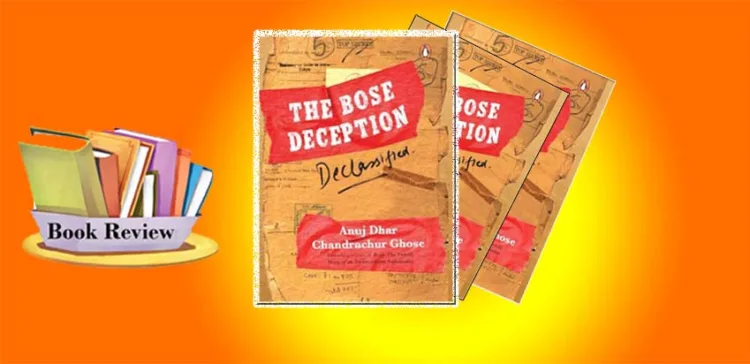Pp 579, ₹ 999
The controversy surrounding Netaji’s disappearance demands attention. Thanks to the persistent efforts of Anuj Dhar and Chandrachur Ghose, more than 1,300 secret archives about Bose have now been declassified. The Bose Deception: Declassified unapologetically sheds light on this critical issue and much more.
In January 2016, the Government of India started declassifying categorised PMO, MEA, MHA and Cabinet Secretariat documents associated with the mysterious ‘disappearance’ of Subhas Chandra Bose during the Second World War. No one would have imagined that even 700 years after Bose’s disappearance, the authorities had been maintaining lots of documents associated with him in utmost secrecy.
The legitimate view that Bose died in an airplane crash in Taiwan is by no means based on public acceptance. It is due to more than one inquiry. Claims, counter-claims and conspiracy theories persisted to complicate the thriller for almost 75 years, chiefly due to the fact of retaining statistics hidden from public view.
Dhar and Ghose have combed through over 2,000 declassified Indian, the UK, the USA and Taiwanese records in this engrossing investigative endeavour to unravel the complex of a deception plan that has kept the complete United States on tenterhooks for decades. They unravel the plot layer using layers to weave a story that is certain to shock the readers.
In The Bose Deception, Anuj Dhar and Chandrachur Ghose have tackled the enduring mystery surrounding the purported death of Subhas Chandra Bose with exceptional skill and rigour. This meticulously researched narrative not only challenges the official account of the plane crash that allegedly took his life but also engages the reader in a thrilling exploration of political cover-ups, bureaucratic inertia, and Government secrecy. Utilising documents obtained through the Right to Information (RTI) Act, the authors have crafted a narrative that is as captivating as it is enlightening, transforming what could be a dry recounting of facts into an exhilarating thriller.
From the very first chapter, The Bose Deception grips readers with its clarity and engaging style. The authors adeptly avoid the pitfalls of convoluted bureaucratic language, making complex topics accessible and compelling. They allow the documents to speak for themselves, unfolding the mystery of Netaji’s fate in a way that feels organic and suspenseful.
A standout feature of this book is its illumination of the consistent silence from political leaders and high-ranking bureaucrats over decades. The prevailing narrative that Bose died in a plane crash in 1945 has remained largely unchallenged. Despite three official commissions designed to investigate the incident, none have arrived at satisfactory conclusions to the myriad questions surrounding Netaji’s death. The persistent refrain from officials has been, “Nothing to see here; it was all settled by the three commissions.”
However, the authors confront this complacency head-on, presenting robust evidence that suggests there is much more to the story. They compel readers to question why a conspiracy of silence persists regarding Bose’s fate. This issue transcends mere historical debate; it raises significant concerns about national security, historical integrity, and the credibility of our political system. The authors’ astute presentation of facts propels the reader to not only question the accepted narrative but also to ponder the reasons behind the prolonged silence of the powers that be over the years.
The Bose Deception serves not only as a call for historical truth but also as a striking indictment of the bureaucratic and political establishment’s attempts to suppress uncomfortable facts.
The documents featured in the book starkly contrast with the sanitised versions of history frequently presented to the public. Instead of merely offering conclusions, the authors empower readers to piece together evidence from a variety of sources, reminiscent of a detective solving a complex case.
With first hand experience engaging with high-ranking members of the bureaucracy, the authors provide a unique perspective on this issue. The consistent dismissal from officials regarding the need for further investigation is both alarming and revealing. Their casual indifference to the importance of uncovering the truth about Netaji’s fate highlights a troubling mindset, suggesting the matter has been prematurely closed. The book effectively portrays this entrenched mentality while juxtaposing it with the compelling new evidence unearthed through the RTI.
Another significant strength of The Bose Deception lies in its blend of historical analysis and investigative journalism. The book is not merely a thorough exploration of the events surrounding Netaji’s alleged death; it also provides a nuanced examination of the broader political context of those events.
The authors trace the rise of Subhas Chandra Bose as a pivotal figure in the Indian independence movement and scrutinise how his legacy has been shaped and often silenced by those in power. By investigating Bose’s disappearance within the larger political and historical framework, the book effectively argues for the necessity of conveying his story with honesty, irrespective of political ramifications.
The narrative structure of the book enhances its appeal even further. Each chapter reveals a new layer of the mystery, presenting fresh evidence, newly uncovered documents, and previously overlooked details that illuminate the circumstances surrounding the plane crash. Readers feel as though they are stepping into a courtroom, witnessing the gradual construction of the case for Bose’s survival. This engaging format keeps the pages turning as tension builds with each new revelation. The authors’ skillful management of suspense, coupled with complex historical material, underscores their exceptional abilities as both writers and researchers.
In conclusion, The Bose Deception is an essential read for anyone seeking a deeper understanding of one of Bharat’s most enduring mysteries. It not only challenges the status quo but also raises profound questions about history, truth, and the political forces that shape our narratives.



















Comments